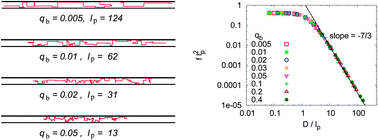Semi-flexible polymer chains in quasi-one-dimensional confinement: a Monte Carlo study on the square lattice
Abstract
Single semi-flexible polymer chains are modeled as self-avoiding walks (SAWs) on the square lattice with every 90° kink requiring an energy εb. While for εb = 0 this is the ordinary SAW, varying the parameter qb = exp(−εb/kBT) allows the variation of the effective persistence length  p over about two decades. Using the pruned-enriched Rosenbluth method (PERM), chain lengths up to about N = 105 steps can be studied. In previous work it has already been shown that for contour lengths L = N
p over about two decades. Using the pruned-enriched Rosenbluth method (PERM), chain lengths up to about N = 105 steps can be studied. In previous work it has already been shown that for contour lengths L = N b (the bond length
b (the bond length  b is the lattice spacing) of order
b is the lattice spacing) of order  p a smooth crossover from rods to two-dimensional self-avoiding walks occurs, with radii R ∝
p a smooth crossover from rods to two-dimensional self-avoiding walks occurs, with radii R ∝  p1/4L3/4, the Gaussian regime predicted by the Kratky–Porod model for worm-like chains being completely absent. In the present study, confinement of such chains in strips of width D is considered, varying D from 4 to 320 lattice spacings. It is shown that for narrow strips (D <
p1/4L3/4, the Gaussian regime predicted by the Kratky–Porod model for worm-like chains being completely absent. In the present study, confinement of such chains in strips of width D is considered, varying D from 4 to 320 lattice spacings. It is shown that for narrow strips (D <  p) the effective persistence length of the chains (in the direction parallel to the confining boundaries) scales like
p) the effective persistence length of the chains (in the direction parallel to the confining boundaries) scales like  p2/D, and R‖ ∝ L (with a pre-factor of order unity). For very wide strips, D ≫
p2/D, and R‖ ∝ L (with a pre-factor of order unity). For very wide strips, D ≫  p, the two-dimensional SAW behavior prevails for chain lengths up to Lcross ∝
p, the two-dimensional SAW behavior prevails for chain lengths up to Lcross ∝  p(D/
p(D/ p)4/3, while for L ≫ Lcross the chain is a string of blobs of diameter D, i.e. R‖ ∝ L(
p)4/3, while for L ≫ Lcross the chain is a string of blobs of diameter D, i.e. R‖ ∝ L( p/D)1/3. In the regime D <
p/D)1/3. In the regime D <  p, the chain is a sequence of straight sequences with length of the order
p, the chain is a sequence of straight sequences with length of the order  p2/D parallel to the boundary, separated by sequences with length < D perpendicular to the boundary; thus Odijk's deflection length plays no role for discrete bond angles.
p2/D parallel to the boundary, separated by sequences with length < D perpendicular to the boundary; thus Odijk's deflection length plays no role for discrete bond angles.


 Please wait while we load your content...
Please wait while we load your content...